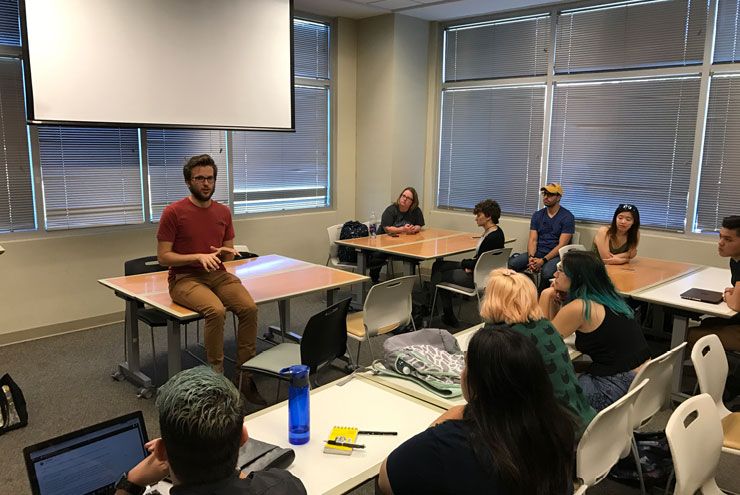By Trevor Boffone
This summer, I taught Introduction to LGBT Studies at the University of Houston (UH). To give some background, 10 students enrolled in my June course: 3 male and 7 female; 5 queer and 5 non-queer (or not out); 8 were from the South; all call Houston home. This course is a powerful experience for both queer and non-queer students alike, as it’s often the first time they are exposed to LGBTQ histories and identities in a formal setting. Even queer students are largely unaware of the cultures and histories of their own community.
Many of my queer students are still working through their own journeys of self-discovery. While a relative few are fully out, others are only partially open about their identities. On campus, they identify as LGBTQ. They have queer friends. They date. They take courses dedicated to LGBTQ studies. At home, they are still in the closet. During my first semester teaching this course, I stopped class one day and asked everyone to be completely honest in responding to the following question. I asked them to raise their hands if their parents knew they were taking Intro to LGBT Studies. In each section of 30 students, roughly half of the students raised their hands. In equal parts, queer and straight students were hiding from their families that they were enrolled in the course. At this moment, it truly hit me as to why this course was such an important space—this is one of the few places where my queer students feel 100 percent comfortable with their sexualities. They are out. They talk about it. They work through it. They embrace themselves.
Given this, I began to look for opportunities to have my students analyze their unique intersecting identities and ultimately decided to have each write an essay reflecting on their own self-perceptions. The only requirement was that they analyzed how their different identity markers intersect with each other.

Spectrum South writer and guest speaker Josh Inocéncio discusses identity in Intro to LGBT Studies at the University of Houston.
Shortly after my summer class began, Spectrum South launched with its series of narrative pieces in which the publication’s core group of writers explored their own queer and southern identities. While each piece was unique to the writer, all of them spoke to the intersections of identity and journeys of queer self-discovery. This inspired me to use these pieces—written by queer millennials—to get my students thinking about their own identities (queer and not) on a deeper level. Each student was assigned a different Spectrum South essay and completed a brief presentation on their narrative and the writer. Students then wrote their own essays exploring the intersecting nature of their identities. In the end, Spectrum South helped start a conversation for my students to explore their own sexualities and genders through writing.
While countless narratives of queer identity exist on the Internet, what struck me most about the ones on Spectrum South was not only their focus on queer millennial identities, but also on the South. As nearly all of my students are from the South, their struggles are not unlike the ones featured on the website. It was a powerful experience to witness just how much my students connected with the writers’ personal narratives, even though they don’t personally know them.
My students quickly noticed one common thread—the majority of writers had to leave home in order to truly discover their identities and understand their sexualities. While Spectrum South writer Josh Watkins needed to move from New York to Texas to embrace his queer identity, it was Texan Josh Inocéncio’s time away at graduate school in Florida that allowed him to come out. Nearly each of my queer students had a similar experience of needing to be away from their homes and families in order to have the freedom to explore and better understand their identities.
One student, a 45-year-old bisexual man, discussed his own journey as a queer parent alongside Laura McGuire’s essay “The Road to Truth: Finding Strength as a Queer Parent.” He explained to us how he was married to a woman when he realized he was bisexual. Once he came out to his wife, she immediately disowned him, telling their two young boys that their dad was gay and that they couldn’t be around him without their shirts on. As with McGuire, the student’s religious upbringing and southern surroundings influenced his identity formation—access to and knowledge of bisexuality was almost non-existent.
Another student connected with Megan Smith’s piece, “A Seat at the Table: Justifying Queer Femme Identity.” The student wrote a paper about her own femme presentation, divulging that—as a customer service worker at a Baptist-owned store—her queer identity is undetectable at work. Because of this, she often feels like an undercover spy. Indeed, as Smith discusses, the journey of being both feminine and queer is a “lonely line between passing in, but not belonging to the straight world, and belonging to, but being invisible in the queer world.”
In the end, the Spectrum South series on southern queer identities was the perfect catalyst to get my students thinking more critically about their own identities. How has the South influenced their identity formation? What does it mean to be both queer and southern? While my students are continuing to tackle these questions, one thing is clear—reading others’ journeys to embracing personal queerness is a vital step toward understanding one’s own identity.







